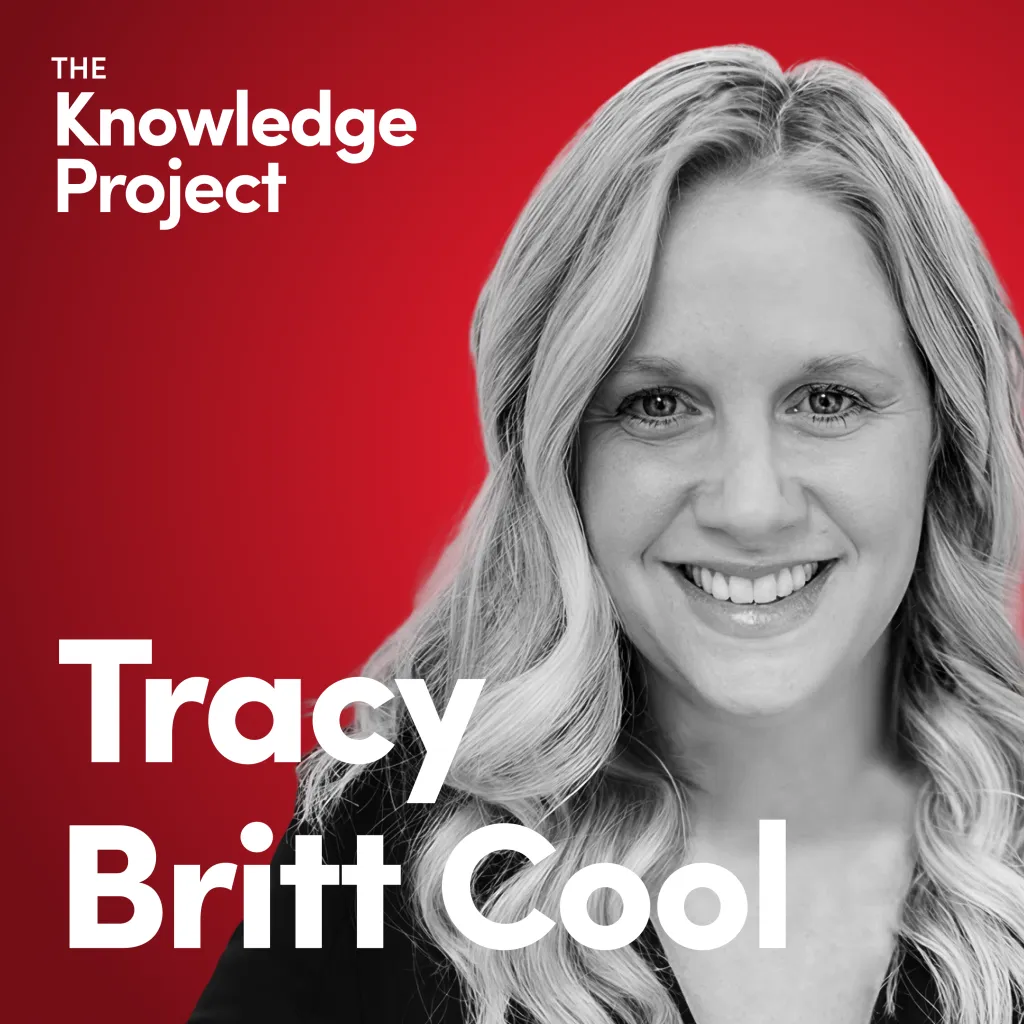Tracy Britt Cool: Building Great Businesses
Blog: Farnam Street
Tracy Britt Cool is the co-founder of Kanbrick where she is applying what she learned at Berkshire Hathaway to the middle market.
In this episode, you’ll learn how she went from writing a cold letter to Buffett to being sent in to fix struggling Berkshire subsidiaries, how to evaluate a business, the types of people to avoid at all costs, the mistake almost every makes when hiring, the three elements of long term thinking, and so much more.
Featured clips

Lessons from Berkshire

The Three Elements of Long Term Thinking

Turing Around a Declining Business

Evaluate a Business like Buffett

What Most People Get Wrong When Hiring
(This is a rare case where the public and private feeds vary. The private feed is about 15 minutes longer and contains details that 99 percent of people won’t care about. If you’re one of the 1%, you can sign up here.)
Available Now: Apple Podcasts | Spotify | Youtube | X | Transcript
Lessons
- Everything is capital allocation. Your primary job is time allocation. Every decision is a resource allocation. You can ruin a good business with poor allocation. All decisions are investment decisions.
- Structure creates outcomes. Everyone says they think long-term. Few have the structure to support it. Intentions mean nothing without infrastructure.
- Do the work upfront. Create deep scorecards before posting roles. Define the mission, outcomes, and competencies before you start with the job description. Then proactively find the best person for the job instead of waiting for applications. Discipline up front saves years on the back end.
- Relentlessly focus on the basics. After two years of growth at Pampered Chef, Tracy hit a wall. She lost sight of the fundamentals.
- Avoid politicians. The biggest tell of incompetence is evasion. Ask a direct question, and they won’t give you a direct answer. They’ll dance around it. Push harder, and they’ll dance some more. People who really know their craft know why something works and why it doesn’t. They understand the issues even if they can’t fix everything yet. Clarity reveals competence.
- Everyone needs to understand the business drivers. Tracy took her entire leadership team through business drivers training every year. She walked them through an income statement. Explained what everything means and how things flow through the business. Too many people assume everyone knows, and if they don’t, they feel too embarrassed to ask.
- If you’re on slide 112, something is wrong. Figure out what actually creates the most value in this business and spend your time there. Tracy remembers one board meeting debating product packaging in detail. Another where she sat through slide 112. Focus on what moves the needle and ignore the theater.
- Asking WHEN changes everything. When Tracy goes through someone’s work history, she asks who their manager was. She writes it down. Sally Smith. What years? Then: “When I call Sally, what will she say about your strengths and development areas?” Notice the language. Not if, when. That one word changes everything. People become more honest because they know you’ll actually check.
- The best are always learning. Warren reads every day and gets smarter. Continuous improvement compounds over decades. The best people have a natural curiosity about solving issues, even outside their area of expertise. They ask about things they don’t own. They want to understand how the whole business works. Curiosity compounds.
- The newspaper test. “If this decision were on the front page, written by a fair, critical reporter your family would read, how would you feel?” Not what’s legal. Not what you can get away with. Reputation the hardest asset to rebuild.
- Find joy in your work. Tracy’s dad loved farming. He worked harder than anyone she’d ever seen. Late nights, early mornings, all summer long. Throughout winter, he took a small break. But it wasn’t work to him, it was what he loved. You can’t compete with someone having fun.
- Independence builds problem solvers. Tracy learned independence early. She was driving at 11. At eight, she ran a farmer’s market stand alone. Her dad dropped her off in the morning and picked her up at night. She hired friends and grew sales from $500 a week to $1,500. The best way to learn is by doing when nobody’s watching.
- People want to help. Tracy wrote letters to CEOs asking to pick their brain. Most said yes. That’s how she landed her job at Berkshire Hathaway. People want to help other people, especially young people who ask good questions. The only barrier is not asking. She wasn’t looking for a job. She wanted to learn. That sincerity opened doors that would’ve stayed closed. Access follows curiosity.
- Skate where the puck is going. Value creation is moving from buying to operating a business.
- Get the system working. The best companies have repeatable business systems (ex., Danaher, Toyota, Constellation). They manage businesses in integrated ways where components reinforce each other.
Highlights and Takeaways
A compression of things that stood out to me from my research and this conversation.
- Everything takes longer and is harder than you think.
- Problems need to be solved at the right level.
- The source of all bad decisions is blind spots.
- It’s not work if you love it.
- Find people with energy, intelligence, and integrity.
- The best are always learning.
- The CEO job is very lonely.
- “If you only think about the long term, you probably won’t get out of the short term because you’re going to miss the situations of today.”
- Structure creates outcomes.
- If you’re trying to attract talent to a losing team, focus on the value proposition to the employee.
- “You don’t usually get payback on things as quickly as you think.”
- Culture is the foundational aspect of every business.
- Hiring someone for $100K is a million-dollar capital allocation decision.
- Avoid the people who hand-wave and go all over when you ask a simple question.
- Everyone needs to know the key drivers of the business.
- The best people are curious.
- People can’t copy discipline.
- “The more leverage you put on the business, the more everything has to go well for the business to be able to service that.”
- Long-term thinking requires structure, not just intent.
- If you’re on slide 112, something is wrong.
- The best candidates don’t apply; you have to find them.
- Think about your business as if it’s your family’s only asset and you can’t sell it for 50 years.
- You can’t buy good people wanting to work with you; you have to earn it.
- If you’re not having fun four days out of five, it’s not the right fit.
- When leaders grow up in businesses, they gain depth but lose outside perspective.
- “I am a better investor because I am a businessman, and a better businessman because I am an investor.” — Warren Buffett
- You save time today, but lose time later when you hire the wrong person.
- Capital is commoditized now. You create value through operating, not financial engineering.
- Where’s your people calendar? You need the same discipline for talent as for budgets.
- Don’t fight the trend. Skate where the puck is going.
- Make sure you pass the newspaper test: “If this decision were on the front page, written by a fair, critical reporter your family would read, how would you feel?”
- Asking WHEN changes everything.
The 5 M Framework to Evaluate Investments
- Moat. What is the moat? What’s the competitive advantage?
- Market. “You may have a moat, but is the market growing and do we think it’s an attractive market? What is the growth rate? What are the likely dynamics of that?”
- Management. “Does it have a strong management team today, or is it something where we think we can help build the management team if there are opportunities? Sometimes there’ll be a great business, it’s got three strong leaders, but they need to build out a sales leader or a talent leader or a finance leader, and can we help them do that?”
- More potential. “There’s some opportunity that’s not being fully leveraged today that we think we can help them with. It might be expanding into new markets. It might be a more structured approach to how they manage the business today. There’s a variety of different avenues in terms of more potential, but absolutely a focus.”
- Margin of safety. “And what we mean by margin of safety is that we don’t want to have to have everything go perfectly right in order for us to be successful. We want to have a little bit of flex so that if there is something like COVID or a downturn or tariffs, we can navigate that well with the management team and we don’t put undue pressure on the business to make shorter-term decisions because of something that’s happening that may be outside of our control.”
Still Curious?
These were mentioned in the episode.
- Alan Mulally‘s Ford Turnaround
- Katharine Graham
- Melinda Gates: The Next Day: Transitions, Change, and Moving Forward
- Bryce Hoffman: American Icon
- Who: The A Method for Hiring
The post Tracy Britt Cool: Building Great Businesses appeared first on Farnam Street.
